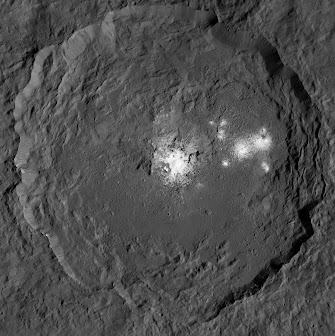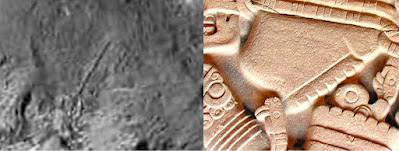leading from
a) Disk depicting a dismembered Coyolxāuhqui, a figure from the Aztecian religion, which was found during a construction in 1978 in Mexico City
(The stone was likely created under the rule of Axayacatl (1469–1481 AD))
(Many thanks to Waabooz Oneill for posting a link to an image of it being uncovered)
b) Occator Crater on Ceres , first photographed in 2015 by the Dawn probe
c.i) Nameless land area that becomes the whole torso
c.ii) The nameless land area that becomes shoulders and breasts
c.iii) Nameless land area and lower torso
d.i) Cerealia Facula and its equivalent
d.ii) The tholus in Cerealia Facula becomes the knot along the snake’s body
e.i) Vinalia Faculae and its equivalent in the crater formations
e.ii) The area known as ‘the stars’ becomes the knot and the loop in the the snakes’ bodies
f.i) Red lines sketching out the areas which I think have been transformed into this sculptural disc.
So I
acknowledge that the actual crater doesn’t depict the scene shown on
the relief, but it’s as if the sculptor has freely interpreted the
crater’s land formations
with their details to make the scene shown in the relief.
I think that
this ability to creatively interpret the place is something that people
can do this today in their living room today without the aid of photos
of the crater, a spacecraft or telescope.
I
might be able to improve the accuracy of my drawing in good time but
there would be a fair amount to be left to free interpretation anyway.
Something
that I would like though is that it intrigues me how the white areas
seem to have been partly transformed into knotted snakes, although there
are more of the knotted snakes than white areas.
The
proportions are not exactly the same, and the relief is complicated
enough as it is, so unfortunately it is not easy to make out anything
that I have drawn but get a general idea of the area that has been
transformed.
I
can’t say what should be so special about this crater across the solar
system other than it does seem to be a very bewildering looking
f.ii) The red line sketch by itself












No comments:
Post a Comment